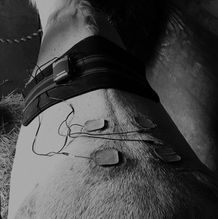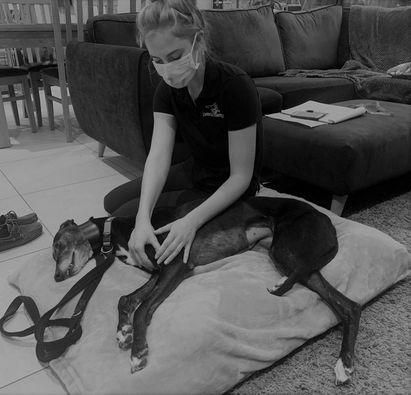
EQUINE PHYSIOTHERAPY
WHAT ARE THE BENEFITS FOR YOUR HORSE?
Physiotherapy can be of benefit to any horse. It can help with such a wide range of issues including maintenance, mobility and post-op recovery. Whether your horse is actively competing, a happy hacker, or enjoying a quieter life treatment can still benefit them.
PERFORMANCE ENHANCEMENT
If you have a horse actively competing in any discipline, or training with aim of achieving this physiotherapy is Pivotel to their wellbeing. Just like human athletes, our horses require treatment to support them reaching their goals
-
Reduce tension that may have an affect on movement/performance
-
Improve flexibility/movement
-
Aid in strengthening/identifying areas of imbalance.
INJURY RECOVERY
If your horse is recovering from surgery or injury, physiotherapy should always be considered to optimise their rehabilitation.
-
Encourage optimal healing
-
Optimise recovery with use of appropriate exercise and treatments
-
Aid in reduction of pain and discomfort
-
Help with re-educating movement
-
Reduce compensations that may arise.
-
Help you manage your horse through recovery
PAIN MANAGEMENT
Like us, horses can develop areas of tight muscle and restriction that can cause them pain or discomfort. Through a range of treatments and therapies I can help...
-
Reduce pain and discomfort
-
Help you horse move better through reducing potentially uncomfortable tension
-
Work toward ensuring the cause of the discomfort is identified and dealt with
-
Improve your horse's wellbeing, mobility and performance.
TREATMENT MODALITIES REGULARLY USED
As a veterinary physiotherapist I am trained in the use of a wide range of treatments. This means I have lots of tools in my belt to help provide your horse with the best treatment possible. Please see some treatments I use below...


MANUAL THERAPIES
Massage can not only be used to reduce tension in muscle tissue, but it has also been proven to help reduce pain via helping to reduce the activity of trigger points and release of endorphins. It can also help with recovery of tissue at various stages helping them to heal as effectively as possible. In addition to this by reducing the amount of tissue tension present massage can allow for postural adaptations to occur. This reduction in tension can also be helped by the use of effective stretching.
TENS
Transcutaneous electrical nerve stimulation (TENS) has been used to help manage pain by humans for many years and the awareness of its effectiveness with animal use is growing. When used on animals, different settings are used to help reduce pain via the release of endorphins. Use of TENS can help to reduce muscular pain in your animal, and if it is needed as part of a more longer term treatment plan you can be taught how to apply and use the machine.
PHOTOBIOMODULATION
Photobiomodulation can be used to help treat a variety of conditions. It works via the absorption of light photons by the cells in the body and depending on the setting it is used on it can have a variety of effects on tissues that range from reducing pain to optimising healing of tissues and reducing inflammation. Research has proven photobiomodulation to be an effective alternative and addition to traditional pain management.
-
Stretching
-
Massage
-
Myofascial release and may more...
-
Class 3b laser
-
Photizo


ROCK TAPING
The use of kinesiology tape has been growing in popularity within the animal rehabilitative community after it rapidly became known for its various abilities when used on human athletes. Not only is it thought that kinesiology tape can aid in supporting of joints but it can also be used to aid in the reduction of inflammation, increase proprioception and help to reduce pain. Although it is not for every case I do have a range of tapes that are specifically made to be used on horses!
PEMFT
Pulsed magnetic field therapy is the use of electromagnetic waves that are sent out via a specialist piece of equipment. It can be placed near, or over an animal and does not cause any discomfort while in use. When used on different setting these electromagnetic waves can have a variety of effects. It has been proven to be extremely effective at aiding the healing of fractured bones as well as reducing pain and inflammation.
Pulsed electromagnetic field therapy
PHYSIOTHERAPY EXERCISES
-
Dynamic mobilisation exercises
-
Rehabilitation plans
-
Ridden and ground work exercises
Just like a human physiotherapist, veterinary physiotherapists are able to prescribe exercise plans and hydrotherapy plans for maintenance or rehabilitation. We are trained to be able to assess an animal and formulate an individual plan to benefit them whatever their needs. As well as this we are trained to teach owners how to do prescribed exercises effectively and confidently.
"What does a initial session look like?"

Mae
Before I see your horse, I will have recieved a signed consent form and clinical history from your vet. This is all organised when your session is booked in and I am more than happy to contact the vet. As part of your horses team, it is really important I have this information so that both you, and your horse can get the most out of the session.
On arrival I will then have some questions to ask you about your horse, current exercise, issues and goals etc. After this I will assess your horse standing and moving. A gentle 'hands on' assessment is usually the next step. Here I feel your horse's muscles, tendons and joints. I may then assess the movement of specific joint passively, or through active movement. If deemed appropriate, a spinal or neurological tests may be carried out.
After this I will discuss my findings with you and explain my treatment goals for the session. Your horse will then receive treatment. If needed I may want to leave with you some treatment/exercise to do with your horse. If this is the case, I will work with you to ensure that you are comfortable with performing any prescribed exercises.
A full write up of my findings will be sent to your horse's veterinarian and any other professional working with them (i.e. hydrotherapist/chiropractor/rider/instructor). If throughout the assessment I notice something that is of concern (i.e. a new undiagnosed condition/lameness), I will refer your horse back to your veterinarian to determine the cause. This is in the best interest of your horse and to allow for my treatment to be targeted and safe.
Looking for something specific? Please get in touch, not all of my treatments and electrotherapy's are outlined above











